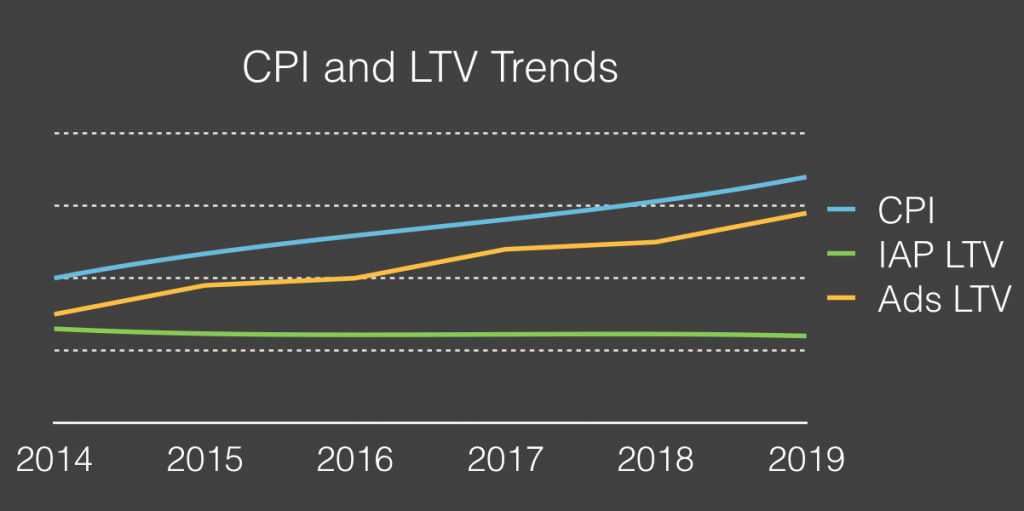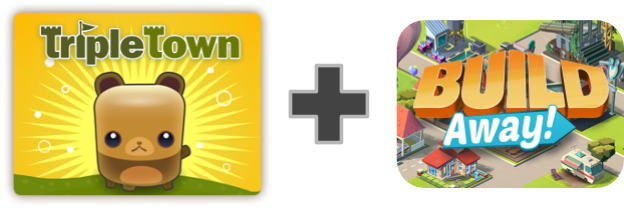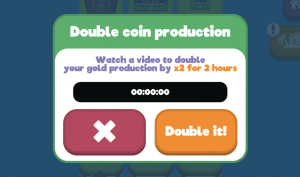Deconstruction of Merge Town!: the Heyday of the hyper-casual genre
About a new round in the development of the mobile games industry and one of its brightest representatives, – on the pages mobilefreetoplay.com told Adam Telfer (Adam Telfer), a former product-lead Wooga. We publish a translation of the material.

Adam Telfer
Rewarded videos over the past few years have firmly entered the frituplay. Ketchapp and Futureplay were the first to prove that developers can profit from video advertising, and advertisers can find a grateful audience among mobile players. In the last two years, the popularity of video advertising has peaked. Rewarded videos are no longer a secondary way to make a profit, and the proceeds from this method of monetization have become the main source of income for many freeplay studios. The creation of projects for video advertising has opened up space for innovations that the matured mobile market needs so much.

CPI and LTV growth dynamics (SOOMLA)
With the growing popularity of rewarded videos, a new era has begun in mobile game design. For years, the casual segment was dominated by a three-in-a-row model from King, and the rest of the games made a profit with great difficulty. Video advertising made it possible to monetize the user base by 100% and thereby opened the way for such games to the consumer. Instead of trying to somehow tie in-game purchases to their casual titles, developers can now make a profit from an active audience, even if they have nothing to sell.
This phenomenon is called “the heyday of the hyper-casual genre”. Johannes Heinze from AppLovin described it like this:
AppLovin
The heyday of the hyper-casual genre is an exciting phenomenon, because it goes against what the fritupley market has come to now, that is, with huge budgets, a multi—year production cycle and growing risks. Hyper-casual games are new and unusual, they are not long to develop and easy to promote.
One of the many companies that have managed to make money on the hyper—casual trend is Gram Games. Games like 1010! and Merged were not made for long, but they earned enough to support developers — a medium-sized studio from Turkey (which recently opened another office in London).
One of the latest projects of Gram Games is Merge Town!, a hybrid of a puzzle and an idler. In the top of the most downloaded British games, the game reached the third place, and in the American top — the twentieth. The game clearly demonstrates the latest achievements in the field of video replay and will serve as an excellent example for those who are just starting to study the topic. The developers perfectly integrated video advertising into the project, but also created an unusual game cycle. Let’s take a closer look at the game.
Gameplay
In fact, Merge Town! — this is a puzzle with the economy of Idler.

The gameplay reminds Threes! and Triple Town in the sense that the player is invited to combine the same houses to improve them.

Above you can see how the main gameplay looks like: you take and combine any identical elements with each other. Unlike Triple Town or Threes!, there are no restrictions. If you put one element (house) on another, then an upgrade will occur and an improved element (double house) will be obtained. The action repeats and repeats, and as a result, more and more composite elements are obtained.
In Threes! and Triple Town’s task was simple — to hold out as long as possible. Merge Town! the goals are more like an idler. You can’t lose, you can only optimize the process. You need to create new elements — to combine them with each other, — to create new elements, — to collect in—game currency, – to buy new, improved elements.
The gameplay follows the following cycle:
1. Elements are created first. To do this, the player needs to either tap the button quickly or wait.

2. After the player receives the elements, they need to be combined to upgrade and free up space for new houses.

3. Improved houses generate more soft currency.

4. With the received currency, the player buys improved houses.
In general, the gameplay is much simpler and more accessible than in Threes! or in Triple Town.
Triple Town was more difficult because there were restrictions on movement and it was possible to lose. Merge Town! more like a reinterpreted idler. The developers don’t just offer tap-tap-tap to progress — they’ve added a little more complex and attractive mechanics.
The user does not even need to pay special attention to the currency. The gameplay, in which you just have to match the same elements with each other, does all the work for the player. It turns out not so much a puzzle as a pleasant activity.
In my opinion, this means that the most important part of the idler is the meta—game and the economy. If you just click and click, you will get another Cow Clicker (a 2010 game in which the player is given a cow. He can click on it and in six hours he will get another opportunity to click on it. The game has the opportunity to buy premium cows and skip the timer for money, – approx. editorial offices). To update the genre, you need to add interesting mechanics to the idler economy, and not just force the player to tap on the screen again and again. And Merge Town! it succeeded. The game is focused on a wide casual market, and at the same time is based on the economy of the Idler.
Integration of the Idler economy
To integrate the idler economy into the gameplay, the designers of Merge Town! I had to work hard. After all, if players can upgrade buildings themselves, then why do they need currency?
Gram Games solved the problem by making a soft currency – gold coins – the currency of skipping time. For it, you can buy already improved houses, due to which progress accelerates, and the economy, thanks to the exponential nature of design, slows down.
It turns out that at one of the segments of the game cycle, players enter the store and spend soft currency to speed up progress and buy the best models of houses. It seems that this is similar to the Idler economy: I buy something all the time to increase the speed with which I maneuver a soft currency. But in fact, the sensations are completely different. An effect that any designer should strive for.
Over time in Merge Town! additional construction sites are being opened on which new houses can be built, thereby creating a visual sense of progress. But in the end, you still get bored. And the next major update is getting farther and farther away.
In order for players not to get bored when the forward movement has slowed down, most idlers use various tricks that force the progress to be reset. These tricks are disguised as permanent progress boosts. That is, the constant zeroing of progress, as it were, helps players to move forward and move forward. Merge Town! applies tougher tactics.

At some point, a new playing space opens to the right of the main field. The player is offered to rebuild a separate city. The soft currency in this city is completely different, so all previous progress in the new zone is useless. A serious departure from the mechanics familiar to Idler.

This solution has its pros and cons.
On the one hand, the feeling of casualness does not disappear, because progress is not lost — the first city is functioning, it can continue to upgrade. Outwardly, all the progress remains in place, because my improved houses have not gone anywhere. There is no sense of injustice, as in many idlers.
But the result is that the sessions are getting longer and longer. At the same time, the game rewards the user for activity. That is, as you move forward, you have to manage more and more sites, which makes the sessions more and more tedious.
But long sessions are exactly what Gram Games wants from the player. The longer the session, the more time the user will spend in the game and the more video ads they will watch. Therefore, it is not in the interests of Gram Games to specifically limit the length of sessions. That is, from the point of view of design, everything is, in principle, correct — except that the sessions as a result tire the players.
Advertising strategy
The advertising strategy of the project is based on the fact that players are as willing as possible to watch ads and that each active user has as many completed views as possible. Read more about this in my other article.
Merge Town Developers! the bicycle was not invented: the economy of the game is based on the economy of the Idler. Merge Town for the most part! copies schemes of popular projects like Farm Away and Build Away. Nevertheless, in order for advertising to work in combination with the main game mechanics, some changes still had to be made.
Here are the four main ways to integrate video ads:
1. Return Bonus
Every time a user returns to the game, he is offered two options — to watch an advertisement and double the amount of soft currency that has accumulated while he was away, or lose everything. The choice is obvious.

This method is great to help users more willing to watch ads. This is helped by a small artificially created currency deficit + benefit. However, since the number of bonuses is limited, it will not be possible to significantly increase the number of views in this way.
2. Upgrade of buildings
During the game, the user is sometimes offered to watch small rewarded videos so that the amount of collected currency will increase in exchange for viewing.

Players can use this method without restrictions, so it perfectly helps to increase views. In most games, it is impossible to constantly offer rewarded videos: the balance would collapse or progress would become too fast. In Merge Town! the amount of currency is growing exponentially, and therefore small boosts do not cause harm.
3. Double revenue within two hours
Just like in Build Away and Bit City (which I’ve disassembled here), in Merge Town! the player can briefly double the production of soft currency by watching a video.

This method helps users to perceive advertising better. But due to the time limit, it will not give a large number of views. Plus, this method has more influence on the design of sessions than directly on monetization: players get an excuse to return every two hours.
4. Forced views
Finally, Gram Games shows the player ads from time to time just during game actions. Sometimes, when a user enters a store (which happens several times per session) or moves between cities (as the player progresses, this happens more and more often), he may be shown a full-screen advertisement that can be “skipped”. This, of course, cannot but annoy, especially when you consider that such advertising appears randomly (I assume that the process is controlled by the number of requests for advertising from the advertiser).
Why does Gram Games need such a method? Isn’t a rewarded video better than a forced showing?
Most likely, this method allows you to monetize those players who would not stay for a long time anyway. Merge Town!, of course, is a cool game, but it cannot interest the player for a long time, like a traditional frituplay like Gardenscapes, Galaxy of Heroes or Clash Royale. But she doesn’t need to. Each game does not have to live for three years and offer an epic hack with guilds and clans. That’s why many vutuplay games give a sense of novelty and have no problems with promotion. Their mechanics allow you to have fun right away, without delay, which most other games cannot offer. And the design is quite simple, so it’s so easy to start playing them right away, unlike a lot of free-play games.
In addition, such a monetization scheme allows Merge Town! sell the version without ads. One in—game purchase – and no annoying video. A very attractive option for the most involved players.
So Gram Games compensates for the relatively short retention curve with an aggressive advertising strategy. There is no benefit to retention from this, but it is only in the hands of developers: they made the choice between retention and revenue in favor of revenue. If you know that the players in your game will not stay for a long time, then retention takes a back seat. But the revenue is not.
Let’s summarize the results
The basis of the game Merge Town! it has become a non-banal and fun mechanics. The game leaves a feeling of novelty and originality. Such a project is easy to promote.
By combining this mechanics with the economy of the idler, the developers have created a game that has every chance to stay on the market and will bring stable profits to the authors for a long time due to video advertising.
A source: mobilefreetoplay.com
